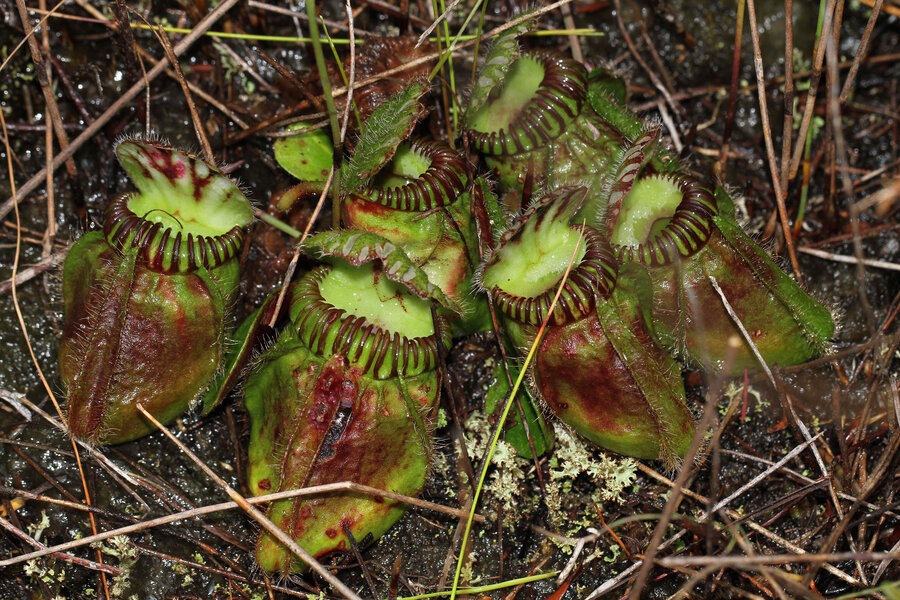Prey or predator? How all pitcher plants came to converge on carnivory
Carnivorous plants have turned the tables on herbivores, eating animals instead of being eaten by them. To capture prey, these leafy predators employ a variety of strategies, from snap traps to sticky leaves to inescapable pits that look like pitchers.
For those so-called pitcher plants, an insect is enticed into the cup by the lure of sweet nectar at the base of the long pitcher. But once a meal is inside, it's difficult to escape up the slippery walls of the hungry pit. As the insect struggles to escape from the soup at the bottom of the cup, digestive enzymes start to break down its body.
There are three types of plants that sport these green stomachs, and, despite their matching methods for munching meat, they're actually not related to each other. But, according to new research, they took parallel evolutionary paths to carnivory.
Scientists were intrigued when they realized over a decade ago just how distant the three remarkably similar plants are. The Australian pitcher plant is more closely related to starfruit than the other pitcher plants, the Asian pitcher plant is more closely related to buckwheat, and the American pitcher plant is more closely related to kiwis. So, in a new genetic study published Monday in the journal Nature Ecology & Evolution, they investigated that surprising evolutionary convergence.
And, it turned out, the plants have more in common than just the superficial similarities. The molecular mechanisms behind the evolution of carnivory in these plants are also a match.
"Since Darwin we've recognized convergence among pitcher plants in their form," Thomas Givnish, a botanist at the University of Wisconsin-Madison who was not involved in the new study. "It's convergence at a shallow level, where things look the same and they act the same."
But now, he says in a phone interview with The Christian Science Monitor, "We see it's also convergence at a very deep level."
Evolutionary convergence actually happens on three levels in pitcher plants, study author Victor Albert, a biologist at the University at Buffalo, explains.
"It's a story of nested convergence," he says in a phone interview with the Monitor. Inside the matching cups, the digestive fluid that breaks down the plants' prey contains the same kinds of enzymes. And the researchers discovered that many of those enzymes were co-opted from the same genetic background in all three plants.
The researchers also found that not only were the identities of some of these enzymes the same, they also underwent the same amino acid changes to evolve to be employed in the plants' carnivory.
"So you've got convergence at three levels," Dr. Albert explains. "You've got convergence at the morphological, the physiological level, and then you've got convergence in terms of co-option of enzymes, and then you've got actual convergence of certain amino acid changes within some of those enzymes. It's really crazy."
Albert and his colleagues sequenced the genome of the Australian pitcher plant, Cephalotus follicularis, and then compared the genetic data for the other two pitcher plants and another carnivorous plant, a sundew species related to the Asian pitcher plant. They focused in on the Australian pitcher plant because it makes both photosynthetic leaves and pitcher cup leaves, so the researchers could compare the two mechanisms on the molecular level.
"It really gets at the ultimate genetic mechanism for how this all works," Aaron Ellison, an ecologist at Harvard University who was not involved in the new study, says in a phone interview with the Monitor.
When investigating the genetics behind the co-option of enzymes for carnivory, Albert and his colleagues found that the pitcher plants' digestive enzymes had their roots in defense mechanisms. These enzymes had previously been involved in defending the plants from herbivorous insects, disease, and other threats.
This is consistent with previous research into perhaps the most iconic carnivorous plant: the Venus flytrap. Researchers last year found that "this plant rewires plant defence against herbivores into offence" by using the hormone jasmonate, which wounds insects feeding on plants upon touch, Dr. Rainer Hedrich, an author of that paper and a biologist at the University of Würzburg, writes in an email to the Monitor.
Research into the Venus flytrap also revealed that the genes expressed in the snappy plant's traps are closely related to those expressed in the roots. As such, that suggests "The traps are there, essentially, to replace the roots, or at least to supplement the roots as a source of mineral nutrients," Dr. Givnish says.
That fits with the harsh environments in which carnivorous plants thrive. Carnivorous plants grow in nutrient-poor habitats, so they aren't getting the nutrients, like nitrogen and phosphorous, they need from the soil. The idea is that these plants evolved carnivory as an alternative way to obtain those necessary nutrients.
Givnish hopes future research on pitcher plants will investigate to see if the same is true in genetics behind the plants' the roots and pitchers.
"Carnivorous plants are a great example of convergence by unrelated groups of organisms to common habitat pressures," Dr. Ellison says. "The methods that people have been applying to carnivorous plants can be applied more broadly to understand convergence" and when traits have evolved by true convergence or simply because organisms had a common ancestor.
The pitcher plants, Ellison says, are a case of true convergence.






